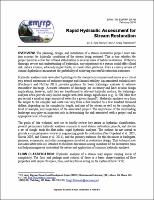Please use this identifier to cite or link to this item:
https://hdl.handle.net/11681/4038Full metadata record
| DC Field | Value | Language |
|---|---|---|
| dc.contributor.author | McKay, S. Kyle | en_US |
| dc.contributor.author | Fischenich, J. Craig, 1962- | en_US |
| dc.creator | Ecosystem Management and Restoration Research Program (U.S.) | en_US |
| dc.creator | Environmental Laboratory (U.S.) | en_US |
| dc.date.accessioned | 2016-03-16T16:16:14Z | en_US |
| dc.date.available | 2016-03-16T16:16:14Z | en_US |
| dc.date.issued | 2016-02 | en_US |
| dc.identifier.govdoc | ERDC TN-EMRRP-SR-48 | en_US |
| dc.identifier.uri | http://hdl.handle.net/11681/4038 | en_US |
| dc.description | Technical Note | en_US |
| dc.description.abstract | The planning, design, and installation of a stream restoration project must take into account the hydraulic conditions of the stream being restored. This is true whether the project involves a few feet of bank stabilization or several miles of habitat restoration. Without a thorough review and understanding of hydraulics, any adjustment to a stream could affect flood risk, induce erosion, adversely impact biota, or create other problems. Even a cursory review of channel hydraulics can increase the probability of achieving successful restoration outcomes. Hydraulic analysis links watershed hydrology to the channel environment and serves as a critical step toward assessment of sediment transport and channel stability. An associated technical note (Fischenich and McKay 2011) provides guidance for basic hydrologic analyses to estimate streamflow discharge. Accurate estimates of discharge are necessary and have serious design implications; however, until they are transformed to relevant hydraulic metrics, the hydrologic analyses often provide only limited insight with little design significance (e.g., Is 500 cubic feet per second a small or large amount of water for a given channel?). Hydraulic analyses vary from the simple to the complex and costs can vary from a few hundred to a few hundred thousand dollars, depending on the complexity, length, and size of the stream as well as the complexity, level of analysis, and importance of the associated project. The importance of the surrounding landscape may play an important role in determining the risk associated with a project and an appropriate level of analysis. The goals of this technical note are to briefly review key issues in hydraulic classification, present preliminary hydraulic analyses common to most stream restoration projects, and discuss a set of simple tools for first-order, rapid hydraulic analyses. The authors do not intend to provide a comprehensive review or engineering guide for restoration (See Copeland et al. 2001, Garcia 2007, and Simon et al. 2011), and the primary audience for this document is biologists, planners, economists, and other nonengineers involved in restoration design. This technical note and associated tools are intended to facilitate discussion among members of the restoration team and help nonengineers understand the nature and application of common hydraulic analyses. | en_US |
| dc.description.sponsorship | Ecosystem Management and Restoration Research Program (U.S.) | en_US |
| dc.format.extent | 15 pages/824 KBs | en_US |
| dc.format.medium | PDF/A | en_US |
| dc.language.iso | en_US | en_US |
| dc.publisher | Engineer Research and Development Center (U.S.) | en_US |
| dc.relation | http://acwc.sdp.sirsi.net/client/en_US/search/asset/1048389 | en_US |
| dc.relation.ispartofseries | Technical Note (Ecosystem Management and Restoration Research Program (U.S.)) ; no. ERDC TN-EMRRP-SR-48 | en_US |
| dc.rights | Approved for public release; distribution is unlimited | en_US |
| dc.source | This Digital Resource was created in Microsoft Word and Adobe Acrobat | en_US |
| dc.subject | Hydraulics | en_US |
| dc.subject | Hydrodynamics | en_US |
| dc.subject | Stream restoration | en_US |
| dc.subject | Environmental management | en_US |
| dc.subject | Environmental restoration | en_US |
| dc.subject | Assessment | en_US |
| dc.subject | Evaluation | en_US |
| dc.title | Rapid hydraulic assessment for stream restoration | en_US |
| dc.type | Report | en_US |
| Appears in Collections: | Technical Note | |
Files in This Item:
| File | Description | Size | Format | |
|---|---|---|---|---|
| ERDC-TN-EMRRP-SR-48.pdf | 823.03 kB | Adobe PDF |  View/Open |